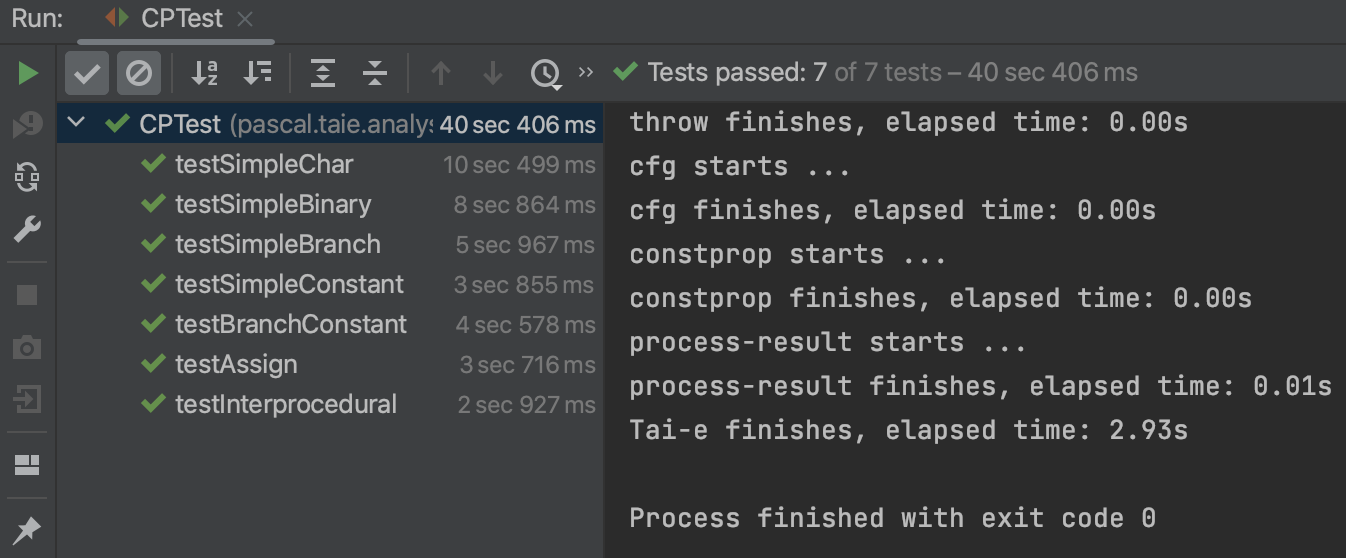前言
这是南大软件分析课程的第二个作业,对应第六节课的内容,实现常量传播模块和Worklist求解器的关键方法。详细实验说明见官方网站。
有了第一个实验作业的基础,这个作业其实不算难。然而,其中需要注意的编程细节要更多,边缘情况也更复杂,这也导致了课程OJ平台上本实验的通过率是所有八个实验中最低的,只有16%。通过率最高的是第一个实验(58%)。我的代码也暂时未能通过所有测试用例(50/52):
2023-03-19 20:30:39 (GMT+08:00) ERROR analysis has "Exception" on [hidden] testcase(s)
Analyze 52 methods, pass 50 methods
There are 481 Stmts in all test cases
Your submission correctly analyzes 472 Stmts
[!] Failed on [hidden] testcase(s)
Tips: we will not give you any information about [hidden] testcase(s)
由于未通过的两个是非公开测试用例,我们无法根据反馈进行针对性的调试。如果你通过了所有测试用例,或者遇到了和我类似的问题,还请告知我,十分感谢。
更新 - 2024-04-13
通过与另一位同学的代码对比,我找到了问题,修改代码通过了所有测试用例,见下文“更新”部分。
任务一:实现常量传播
任务是将ConstantPropagation类的六个方法:
- CPFact newBoundaryFact(CFG)
- CPFact newInitialFact()
- void meetInto(CPFact, CPFact)
- boolean transferNode(Stmt, CPFact, CPFact)
- Value meetValue(Value, Value)
- Value evaluate(Exp, CPFact)
其中,前四个方法分别对应常量传播算法中的边界初始化、非边界基本块初始化、control flow handling和transfer function。meetValue和evaluate则分别是被meetInto和transferNode调用的方法。在任务二中,前四个方法将被我们的Worklist求解器调用。
其中,在实现newBoundaryFact时,我们需要注意将待分析方法的参数初始化为NAC,因为它们是由调用者传入的,一定不是常量。newBoundaryFact和newInitialFact的代码实现如下:
public CPFact newBoundaryFact(CFG<Stmt> cfg) {
CPFact cpf = new CPFact();
for (Var var: cfg.getIR().getParams()) {
if (canHoldInt(var)) {
cpf.update(var, Value.getNAC());
}
}
return cpf;
}
public CPFact newInitialFact() {
return new CPFact();
}
接下来是meetInto及相关方法。这里完全按照课上讲的meet方法编程实现即可:
public void meetInto(CPFact fact, CPFact target) {
for(Var var: fact.keySet()) {
target.update(var, meetValue(fact.get(var), target.get(var)));
}
}
public Value meetValue(Value v1, Value v2) {
if (v1.isNAC() || v2.isNAC()) {
return Value.getNAC();
}
if (v1.isUndef()) {
return v2;
} else if (v2.isUndef()) {
return v1;
}
if (v1.getConstant() == v2.getConstant()) {
return Value.makeConstant(v1.getConstant());
} else {
return Value.getNAC();
}
}
接下来是transferNode方法。这里需要注意的是,应该用.equals()方法来判断CPFact对象是否相等;另外,如果当前语句非赋值语句,那么transferNode里实现恒等逻辑即可。transferNode方法的代码实现如下:
public boolean transferNode(Stmt stmt, CPFact in, CPFact out) {
if (stmt.getDef().isPresent()) {
if ((stmt.getDef().get() instanceof Var) && canHoldInt((Var)stmt.getDef().get())) {
CPFact outTmp = in.copy();
outTmp.update((Var)stmt.getDef().get(), evaluate(((DefinitionStmt<Var, RValue>)stmt).getRValue(), in));
if (!outTmp.equals(out)) {
for (Var var: outTmp.keySet()) {
out.update(var, outTmp.get(var));
}
}
return outTmp != out;
}
}
// for other cases, just assign IN to OUT
if (!in.equals(out)) {
for(Var var: in.keySet()) {
out.update(var, in.get(var));
}
return true;
}
return false;
}
其中,transferNode将右侧表达式求值的任务委托给了evaluate方法。该方法虽然看起来比较复杂,但实际上只需要分情况实现即可:
public static Value evaluate(Exp exp, CPFact in) {
if (exp instanceof Var) {
return in.get((Var)exp);
}
if (exp instanceof IntLiteral) {
return Value.makeConstant(((IntLiteral) exp).getValue());
}
if (exp instanceof BinaryExp) {
in.get(((BinaryExp) exp).getOperand2());
Value v1 = in.get(((BinaryExp) exp).getOperand1());
Value v2 = in.get(((BinaryExp) exp).getOperand2());
if (v1.isNAC() || v2.isNAC()) {
if (exp instanceof ArithmeticExp) {
// consider mod and div by zero
if (((ArithmeticExp) exp).getOperator() == ArithmeticExp.Op.DIV && v2.isConstant() && v2.getConstant() == 0) {
return Value.getUndef();
}
if (((ArithmeticExp) exp).getOperator() == ArithmeticExp.Op.REM && v2.isConstant() && v2.getConstant() == 0) {
return Value.getUndef();
}
}
return Value.getNAC();
}
if (v1.isConstant() && v2.isConstant()) {
if (exp instanceof ArithmeticExp) {
if (((ArithmeticExp) exp).getOperator() == ArithmeticExp.Op.DIV && v2.getConstant() == 0) {
return Value.getUndef();
}
return switch (((ArithmeticExp) exp).getOperator()) {
case ADD -> Value.makeConstant(v1.getConstant() + v2.getConstant());
case SUB -> Value.makeConstant(v1.getConstant() - v2.getConstant());
case MUL -> Value.makeConstant(v1.getConstant() * v2.getConstant());
case DIV -> Value.makeConstant(v1.getConstant() / v2.getConstant());
case REM -> Value.makeConstant(v1.getConstant() % v2.getConstant());
};
}
if (exp instanceof ConditionExp) {
return switch (((ConditionExp) exp).getOperator()) {
case EQ -> Value.makeConstant(v1.getConstant() == v2.getConstant() ? 1 : 0);
case NE -> Value.makeConstant(v1.getConstant() != v2.getConstant() ? 1 : 0);
case GE -> Value.makeConstant(v1.getConstant() >= v2.getConstant() ? 1 : 0);
case GT -> Value.makeConstant(v1.getConstant() > v2.getConstant() ? 1 : 0);
case LE -> Value.makeConstant(v1.getConstant() <= v2.getConstant() ? 1 : 0);
case LT -> Value.makeConstant(v1.getConstant() < v2.getConstant() ? 1 : 0);
};
}
if (exp instanceof ShiftExp) {
return switch (((ShiftExp) exp).getOperator()) {
case SHL -> Value.makeConstant(v1.getConstant() << v2.getConstant());
case SHR -> Value.makeConstant(v1.getConstant() >> v2.getConstant());
case USHR -> Value.makeConstant(v1.getConstant() >>> v2.getConstant());
};
}
if (exp instanceof BitwiseExp) {
return switch (((BitwiseExp) exp).getOperator()) {
case OR -> Value.makeConstant(v1.getConstant() | v2.getConstant());
case AND -> Value.makeConstant(v1.getConstant() & v2.getConstant());
case XOR -> Value.makeConstant(v1.getConstant() ^ v2.getConstant());
};
}
}
return Value.getUndef();
}
return Value.getNAC();
}
更新 - 2024-04-13
上面的evaluate方法的考虑不太到位,具体可以参考下面的代码diff:
@@ -172,11 +171,17 @@ public class ConstantPropagation extends
}
return Value.getNAC();
}
+ if (v1.isUndef() || v2.isUndef()) {
+ return Value.getUndef();
+ }
if (v1.isConstant() && v2.isConstant()) {
if (exp instanceof ArithmeticExp) {
if (((ArithmeticExp) exp).getOperator() == ArithmeticExp.Op.DIV && v2.getConstant() == 0) {
return Value.getUndef();
}
+ if (((ArithmeticExp) exp).getOperator() == ArithmeticExp.Op.REM && v2.getConstant() == 0) {
+ return Value.getUndef();
+ }
return switch (((ArithmeticExp) exp).getOperator()) {
case ADD -> Value.makeConstant(v1.getConstant() + v2.getConstant());
case SUB -> Value.makeConstant(v1.getConstant() - v2.getConstant());
@@ -210,7 +215,7 @@ public class ConstantPropagation extends
};
}
}
- return Value.getUndef();
+ return Value.getNAC();
}
return Value.getNAC();
}
任务二:实现Worklist求解器
任务二涉及两个方法的实现:
- Solver中的void initializeForward(CFG, DataflowResult)
- WorklistSolver中的void doSolveForward(CFG, DataflowResult)
其中,Solver是求解器的基类,WorklistSolver继承了Solver类。
有了实验一积累的经验,这里就比较简单了。首先是initializeForward方法的实现:
protected void initializeForward(CFG<Node> cfg, DataflowResult<Node, Fact> result) {
result.setOutFact(cfg.getEntry(), analysis.newBoundaryFact(cfg));
for (Node node: cfg) {
if (cfg.isEntry(node)) {
continue;
}
result.setInFact(node, analysis.newInitialFact());
result.setOutFact(node, analysis.newInitialFact());
}
}
接着是doSolveForward,也很直观,按照课上讲的算法伪代码实现即可:
protected void doSolveForward(CFG<Node> cfg, DataflowResult<Node, Fact> result) {
ArrayList<Node> nodeArrayList = new ArrayList<Node>();
for (Node node: cfg) {
if (cfg.isEntry(node)) {
continue;
}
nodeArrayList.add(node);
}
while(!nodeArrayList.isEmpty()) {
Node node = nodeArrayList.remove(0);
for (Node p: cfg.getPredsOf(node)) {
analysis.meetInto(result.getOutFact(p), result.getInFact(node));
}
boolean changed = analysis.transferNode(node, result.getInFact(node), result.getOutFact(node));
if (changed) {
nodeArrayList.addAll(cfg.getSuccsOf(node));
}
}
}
测试示例
我们首先用JUnit来测试一下所有本地测试用例,非常方便:

这里我们展示一下对SimpleBranch用例的分析结果。SimpleBranch类的源码如下所示:
class SimpleBranch {
static void NAC(int p) {
int x;
if (p > 0) {
x = 1;
} else {
x = 2;
}
int y = x;
}
}
分析结果如下:
-------------------- <SimpleBranch: void <init>()> (constprop) --------------------
[0@L1] invokespecial %this.<java.lang.Object: void <init>()>(); {}
[1@L1] return; {}
-------------------- <SimpleBranch: void NAC(int)> (constprop) --------------------
[0@L5] %intconst0 = 0; {%intconst0=0, p=NAC}
[1@L5] if (p > %intconst0) goto 3; {%intconst0=0, p=NAC}
[2@L5] goto 6; {%intconst0=0, p=NAC}
[3@L5] nop; {%intconst0=0, p=NAC}
[4@L6] x = 1; {%intconst0=0, p=NAC, x=1}
[5@L5] goto 8; {%intconst0=0, p=NAC, x=1}
[6@L5] nop; {%intconst0=0, p=NAC}
[7@L8] x = 2; {%intconst0=0, p=NAC, x=2}
[8@L8] nop; {%intconst0=0, p=NAC, x=NAC}
[9@L10] y = x; {%intconst0=0, p=NAC, x=NAC, y=NAC}
[10@L10] return; {%intconst0=0, p=NAC, x=NAC, y=NAC}
总结与思考
这个实验再一次证明了“纸上得来终觉浅”。看起来很简单的算法,在实现时有许多边边角角需要考虑。对于我来说,关键是那两个未通过的非公开测试用例。噫吁嚱,意难平!